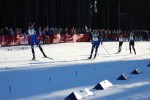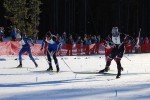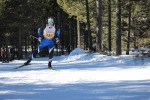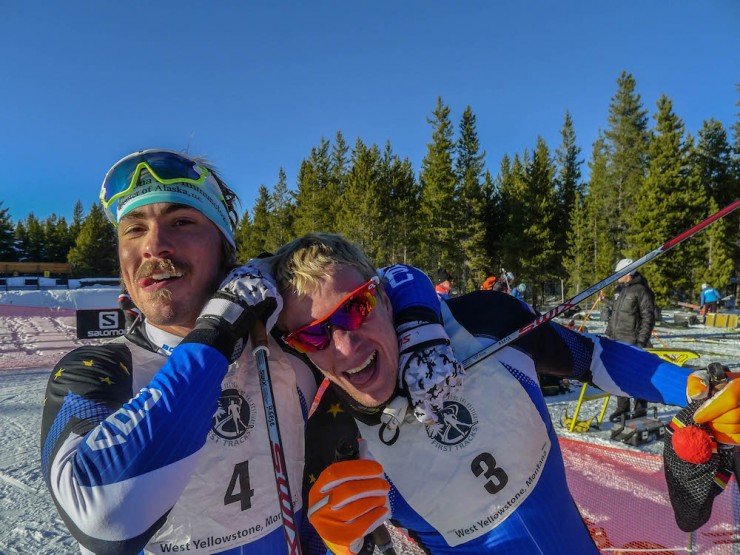
WEST YELLOWSTONE, Mont. – Reese Hanneman spent much of the cold afternoon in West Yellowstone unchallenged on Friday. He cruised to wins in both his quarterfinal and semifinal. However, the challenge came from close to home, as Hanneman led down the final stretch in the men’s final before his younger brother and Alaska Pacific University (APU) teammate Logan powered past him for the win.
After a cold morning with temperatures hovering in the negative single digits, resulting in a two-hour start delay, the men’s field jumped into the first SuperTour race of the season shortly after 11:30 a.m. Nerves were running high as athletes headed out on to the relatively flat 1.3-kilometer course in 15-second intervals to test themselves against the clock and gauge the effectiveness of their summer training.
“The course was in great shape, grooming was perfect,” Reese Hanneman reflected in a post-race interview.
Canadian national-development team member Knute Johnsgaard took the win in the qualifying round in 2:30.9 minutes, 0.72 seconds ahead of defending U.S. national sprint champion Dakota Blackhorse-von Jess of the Bend Endurance Academy.
APU teammates and brothers, Logan, 22, and Reese Hanneman, 25, qualified in third and fourth, respectively, and Canada’s Andy Shields (Thunder Bay National Development Centre) advanced in fifth.
Most of the established elite racers in the men’s field managed to ski their way in to the top 30, earning the right to compete in the afternoon’s elimination rounds.
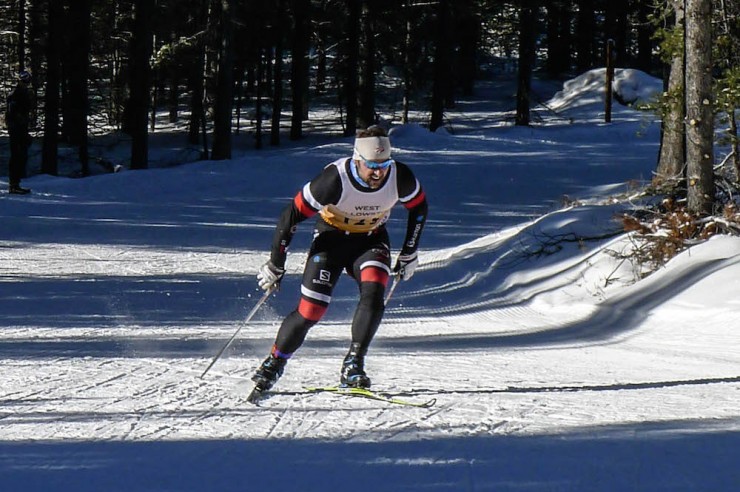
As the rounds progressed, two men skied to comfortable wins in their quarterfinals and semifinals. Reese was one of them and Blackhorse-von Jess was the other, displaying impressive finishing speed to win his quarterfinal by a convincing margin. Johnsgaard and Shields also skied strong through the quarters, as did Matt Gelso of the Sun Valley Ski Education Foundation (SVSEF) Gold Team, after qualifying in 20th. Montana State University’s Forrest Mahlen and Alex Howe (Craftsbury Green Racing Project) also stayed in contention through the semifinals.
When eventual winner Logan Hanneman saw the list for his semifinal, “I thought, ‘Good grief!’ ” he explained. “Mads [Strøm, of the University of Colorado-Boulder], [Ben] Saxton [of Stratton and the U.S. Ski Team], Dakota… I don’t know how this is going to go! That’s a tough group.”
But by the end of the semi, Logan and Blackhorse-von Jess had established themselves as the frontrunners and the finish was almost too close to call.
“At that point, I knew I had a pretty good chance heading in to the final,” Logan said.
When the lucky losers had been sorted out and the start list for the men’s final was posted, Blackhorse-von Jess, Johnsgaard, Gelso, Howe and both Hanneman brothers had reached the final round. Mahlen, Brian Gregg (Team Gregg) and Saxton narrowly missed the cut.
The tension increased as the six men toed the line for the final, with two consecutive false starts due to malfunction with the starter’s pistol.
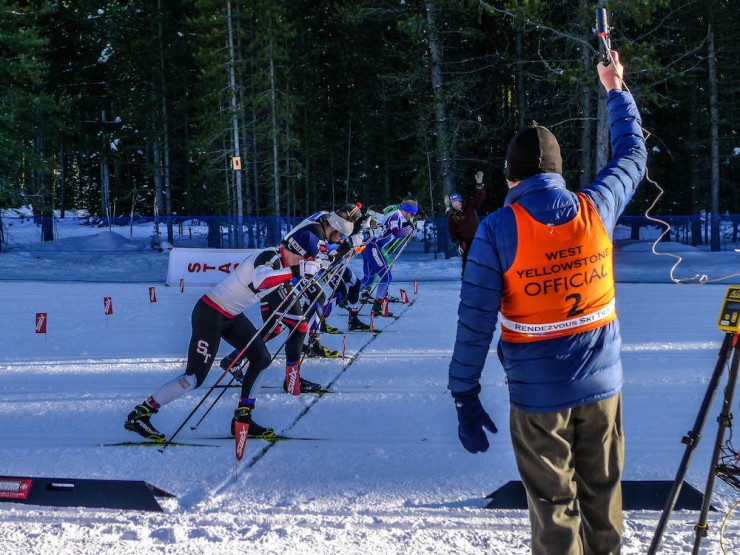
When the gun fired in earnest, Blackhorse-von Jess shot to the front, a move he had used all day.
“If you’re willing to burn your jets early, you can get to that first corner with a lead,” he said afterwards. “It worked for me in the quarters, it worked for me in the semi, and it worked for me last year.”
Several athletes have noted that, on this particular course, there aren’t many spots to pass, which made Blackhorse-von Jess’s strategy successful. Until the final, that is.
“Reese made a really bold move at the bottom of the climb,” Blackhorse-von Jess said. “It’s a risky move, because if you can’t execute it all the way, you can drop from second back to fourth or fifth.”
It worked for the older of the two Hannemans, as Reese moved in to the lead at the bottom of the course’s only real climb.
According to Gelso, who finished fifth, “There was a lot of bumping and grinding in the final. Everyone was amped up and trying to get in to position all the way around the loop.”
“I was thinking that Dakota was the guy to beat,” Reese said. “He’s so consistent. When I saw the chance to get around him at the bottom of the climb, I jumped on it.”
A few skiers back, 22-year-old Logan had been focusing on strategic cornering through the lower “NASCAR” section of the course.
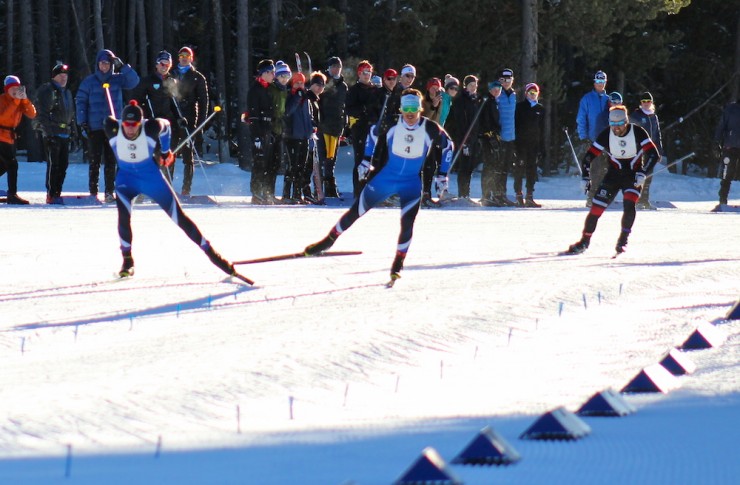
“There’s a corner in there, the last corner before the climb… I’d been focusing on taking a little bit wide in the quarters and the semis and had used that move to pass a few guys each time,” Logan said.
In the final, his timing was perfect. “Just after that corner, Reese made his move, and I jumped on with him and got past Dakota,” he said.
When they emerged from the trees at the top of the climb and made the 90-degree turn to toward the finish, it was Reese, followed by Logan and Dakota, with Johnsgaard, Gelso and Howe close behind. A bit of contact between Gelso and Howe slowed the duo, but in the front, a battle for the win was shaping up between the Hannemans.
“I was leading, but I could hear Logan behind me, then I could see the tips of his skis coming up beside me,” Reese recalled. “I knew that he and Dakota were back there, and when it comes to sheer wattage those guys are so powerful, they’re like a couple of bison. Plus, Logan is like 6’3”. On a gradual downhill like the one leading in to the finish, he’s just so fast.”
Crossing the line with a three-meter lead, Logan grabbed his first-ever SuperTour win, coming off of successful college career at the University of Alaska-Fairbanks. Reese joined him on the podium in second, with Blackhorse-Von Jess there as well in third. Johnsgaard skied to fourth, Gelso was fifth and Howe came in sixth.
“I think I may need to stop giving him all my good hand-me-down skis,” joked Reese, who was both satisfied with his own performance and thrilled with his younger brother’s victory.
The West Yellowstone SuperTour continues with the first distance race of the season, the 10/15 k freestyle individual start on Saturday.
***
About the Author: Travis followed up a somewhat undistinguished competitive career with the University of Colorado with coaching positions in Steamboat, Boise, and most recently as the Gold Team Coach in Sun Valley. As of 2011, he works with middle school skiers, including his own two boys, and sells second homes to dot-com millionaires in Nordic Town USA: Sun Valley, Idaho.

